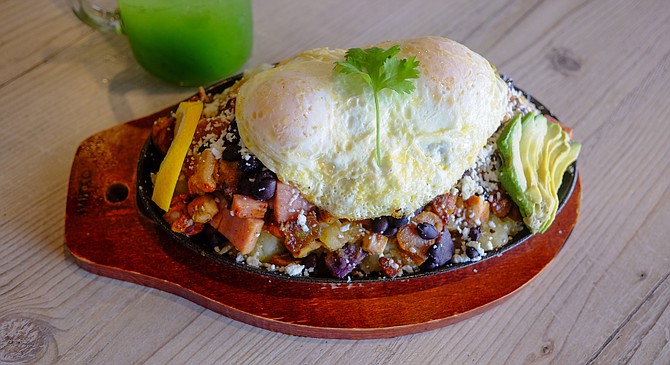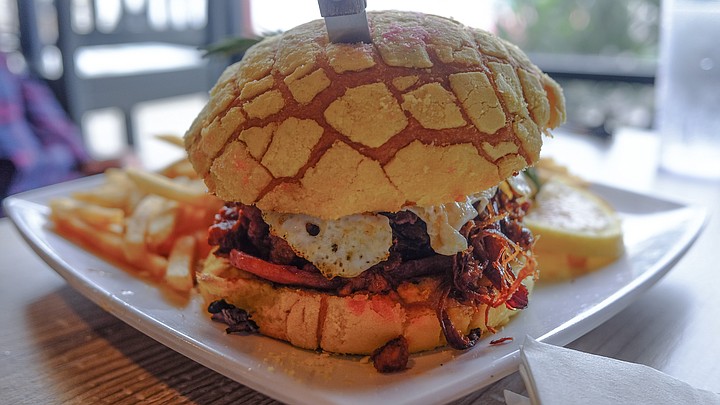 Facebook
Facebook
 X
X
 Instagram
Instagram
 TikTok
TikTok
 Youtube
Youtube

Most breakfast menus tend to be long reads, just not very interesting ones. You’ll find an entire section dedicated to all the predictable variations of eggs, meat, potatoes and toast. Another to pancakes and waffles. Next come the omelets, the chilaquiles (if you’re in San Diego), and several versions of eggs Benedict (if you’re fancy). It gets boring, but it always works.
Nevertheless, a new spot in Chula Vista offers a fresh spin I can’t stop thinking about. While it doesn’t abandon the morning comfort of eggs-plus and coffee, Mexipino Craft does follow through on the promise of its name to combine Mexican and Filipino influences, using them to subvert the classic American breakfast

The concept’s anything but far-fetched. The histories of Mexico and the Philippines have been entwined over 500 years due to shared Spanish colonialism. Beginning in the 16th century, galleons made annual passages between the two. Sailors from both ends of the Pacific often ditched their ships to pursue opportunities in the opposite places, and even more often brought their appetites with them. As a result, modern-day Mexican culture can credit its fondness for mangos and coconuts to Filipino influence, while tens if not hundreds of thousands of Pacific Islander immigrants, going back a dozen generations, contributed to the mestizo ancestry of La Raza.
So, probably the most accurate way to put it is that Mexipino Craft works to continue the fusion of Mexican and Filipino cuisines. And the humble strip mall restaurant takes this work seriously. While its breakfast plus lunch menu covers a great deal of ground, even the conventional Mexican, American, and Filipino dishes prove earnestly made, both in preparation and presentation, whether chilaquiles or traditional Filipino breakfast of crispy bangus (national fish of the Philippines) served with eggs, garlic rice, and tomatoes prepared with soy-sauce derived finedene sauce.
I couldn’t resist trying the restaurant’s signature Mexipino hash: skillet cooked potatoes topped with a cultural kitchen sink of ingredients: black beans, rice, avocado, queso fresco, achiote-seasoned chicken, ham, longanisa sausage, and ube, the Philippines’ famous purple yam.
Plus eggs, of course. Everything came served, piled high on a platter, topped with a pair of over-easy eggs and a sprig of cilantro. Every bite seemed to offer different flavor combinations, most striking when the mildly sweet, the longanisa sausage and ube contrasted the salty ham and soft, starchy potatoes. I managed to eat roughly half of the $14.25 breakfast before boxing up the rest to take home.
A return customer at the neighboring table ordered my second choice, the $13.95 Mexipino breakfast sandwich. This almost provocatively pairs spam with smoked prime beef, finishing the sandwich with eggs, avocado, and chorizo. But the first thing I noticed before my fellow diner quickly devoured it, is the sandwich is made on a concha, the shell-like pan dulce of Mexican bakeries. It looked fantastic.
As did the ube jam crepe, the fried adobo chicken and waffles, and the pancakes made with lechera, the sweet condensed milk used to make dulce de leche. The sheer breadth of breakfast offerings at Mexipino Craft demands multiple visits.


Most breakfast menus tend to be long reads, just not very interesting ones. You’ll find an entire section dedicated to all the predictable variations of eggs, meat, potatoes and toast. Another to pancakes and waffles. Next come the omelets, the chilaquiles (if you’re in San Diego), and several versions of eggs Benedict (if you’re fancy). It gets boring, but it always works.
Nevertheless, a new spot in Chula Vista offers a fresh spin I can’t stop thinking about. While it doesn’t abandon the morning comfort of eggs-plus and coffee, Mexipino Craft does follow through on the promise of its name to combine Mexican and Filipino influences, using them to subvert the classic American breakfast

The concept’s anything but far-fetched. The histories of Mexico and the Philippines have been entwined over 500 years due to shared Spanish colonialism. Beginning in the 16th century, galleons made annual passages between the two. Sailors from both ends of the Pacific often ditched their ships to pursue opportunities in the opposite places, and even more often brought their appetites with them. As a result, modern-day Mexican culture can credit its fondness for mangos and coconuts to Filipino influence, while tens if not hundreds of thousands of Pacific Islander immigrants, going back a dozen generations, contributed to the mestizo ancestry of La Raza.
So, probably the most accurate way to put it is that Mexipino Craft works to continue the fusion of Mexican and Filipino cuisines. And the humble strip mall restaurant takes this work seriously. While its breakfast plus lunch menu covers a great deal of ground, even the conventional Mexican, American, and Filipino dishes prove earnestly made, both in preparation and presentation, whether chilaquiles or traditional Filipino breakfast of crispy bangus (national fish of the Philippines) served with eggs, garlic rice, and tomatoes prepared with soy-sauce derived finedene sauce.
I couldn’t resist trying the restaurant’s signature Mexipino hash: skillet cooked potatoes topped with a cultural kitchen sink of ingredients: black beans, rice, avocado, queso fresco, achiote-seasoned chicken, ham, longanisa sausage, and ube, the Philippines’ famous purple yam.
Plus eggs, of course. Everything came served, piled high on a platter, topped with a pair of over-easy eggs and a sprig of cilantro. Every bite seemed to offer different flavor combinations, most striking when the mildly sweet, the longanisa sausage and ube contrasted the salty ham and soft, starchy potatoes. I managed to eat roughly half of the $14.25 breakfast before boxing up the rest to take home.
A return customer at the neighboring table ordered my second choice, the $13.95 Mexipino breakfast sandwich. This almost provocatively pairs spam with smoked prime beef, finishing the sandwich with eggs, avocado, and chorizo. But the first thing I noticed before my fellow diner quickly devoured it, is the sandwich is made on a concha, the shell-like pan dulce of Mexican bakeries. It looked fantastic.
As did the ube jam crepe, the fried adobo chicken and waffles, and the pancakes made with lechera, the sweet condensed milk used to make dulce de leche. The sheer breadth of breakfast offerings at Mexipino Craft demands multiple visits.
Comments